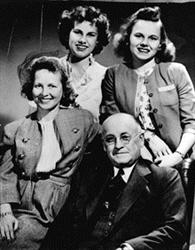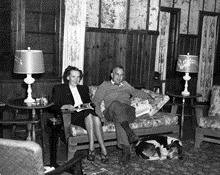A History of
Enterprise
and Innovation

1864
- John Leathem, a lumberman and salvage master who ran a mill at New Franklin but was hindered by poor financial means, visits a machine shop in Green Bay, the owner of which introduces Leathem to his nephew, a trained machinist and businessman, Thomas Smith. Smith agrees to take a look at the mill, but half-way to New Franklin encounters Leathem and his workers returning to Green Bay. Having been paid in promises instead of money, the workers refused to go back to work. Smith, a man of action, rises to the occasion and writes checks to cover the employees wages. A life-long partnership and friendship begins between Leathem and Smith. (Usher 1577)
1867
- The enterprise moves to Red River, on the shores of Green Bay, and Charles Scofield takes financial interest; the business is continued under the name of Scofield & Company.
1975
- Leathem and Smith move to Sturgeon Bay and build a mill.
1881
- Scofield withdraws from the firm and they adopt the name Leathem & Smith
1882
- Transportation by water made cheaper by the opening of the Sturgeon Bay ship canal, helping large-scale quarries thrive.
1886
- Smith obtains a 25 year charter from the county board. Under the title Sturgeon Bay Bridge Company, Thomas Smith, John Leathem and R.B. Kellogg construct the first bridge across Sturgeon Bay, for $30,000
1892
- The Leathem & Smith Towing & Wrecking Company is incorporated with a capital stock of $100,000. Leathem D. Smith serves as president, while Thomas Smith serves as secretary and treasurer.
1893
- Leathem & Smith (dolomite) Quarry established at the mouth of Sturgeon Bay
1894
- Leathem & Smith Lumber Company is incorporated with a capital of $170,000.
1905
- Thomas Smith installs a stone crusher at his quarry
1909
- Leathem D. Smith graduates from the University of Wisconsin with a degree in civil engineering.
1911
- The company’s charter for the bridge expires and on November 2, the city of Sturgeon Bay takes over the bridge
- Smith engineers the raising and rebuilding of the Panther, a steam barge, from Green Island
1912
- Smith sells the rebuilt Panther to Milwaukee’s American Steamship Company, earning him $15,000, with which Smith purchases a quarter interest in Leathem & Smith.
- Leathem & Smith purchase the Adriatic to service quarry operation, which became an important step toward the self-unloading vessel.
1913
- Leathem D. Smith, son of Thomas Smith, and now quarter owner of the firm, supervises the installation of the Adriatic’s self-unloader, able to unload at a speed of about 250 cubic yards per hour; a far cry from the days it took to unload by man-power.
- Leathem & Smith Towing & Wrecking Company
1914-18
- World War I

1914
- Leathem D. Smith takes control of Leathem & Smith, following the sudden death of Thomas Smith, John Leathem having retired several years earlier. With Lethem & Smith’s lumber business having been played out, and wrecking operations diminishing, some of the family supported the liquidation of the firm
1920
- Smith incorporates the Leathem D. Smith Stone Company, capitalized at $200,000, relying on improvements at the quarry to sustain business.
1921
- The umbrella business entity for the Smith enterprises, Leathem & Smith Towing & Wrecking, ceases existence as of January 1, 1921, and is replaced by the Leathem D. Smith Stone Company, and Leathem D. Smith Dock Company (capitalized at $100,000), now known as Bay Shipbuilding
1922
- With the decline of shipbuilding demand, Smith embarks on a $115,000 expansion of the quarry. Within a year, Smith’s quarry becomes on of the largest stone plants in the Great Lakes area.
1915-29
- Stone shipments on the Great Lakes increase 530%, due not only to demand, but also by the presence of self-unloading vessels
1928
- Leathem D. Smith, purchases 100 acre farm from John Nelson and builds Door County’s very first country club and yacht club.
Most of the old farm buildings were razed to make way for new construction. The new Commodore Club included a nine-hole golf course, dock, dining hall, lobby, several cottages, and 22 rooms.
1931
- Due to the Great Depression, rumors begin circulating that Smith would sell the Dock Company yard to a larger shipbuilding group which would shut it down. (Brehm 183) Smith offers for sale $75,000 in bonds, in an effort to secure working capital – “but the offering appears to have been undersubscribed.” (Lafferty 184)
1932
- May. The fiscal fortunes of Leathem D. Smith Dock Company appear bleak with almost no work to be had. “To avoid foreclosure and to placate members of the yard’s management to who he was in salary arrears, Smith agreed to have three employees, including Superintendent Ray Christianson, secure a chattel mortgage against the yard property.” (Brehm 184)
1933
- Leathem D. Smith Dock Company saved from liquidation. The mortgage is discharged when the Dock Company receives a contract form Santa Cruz Portland Cement Company of San Francisco to provide plans and equipment for the conversion of a former U.S. Shipping Board freighter into a tunnel-scraper self-unloading cement carrier.Throughout the 1930s the Dock Company survives on just three ship scrapping contracts, and general repair work
1937
- Depression brings down business at the country club and in the shipbuilding business, and Leathem sells the country club to the Bertschinger family. It is renamed the Lucerne Hotel.
1940
- U.S. Army Corps of Engineers contract four fifty-six-foot tugs, launching Smith’s wartime shipbuilding program. This marks the end of tunnel-scraper conversions on the Great Lakes

1941-45
- Leathem makes his fortune building vessels for the US Navy and Maritime Commission during World War II

1942
- Labor Day: 4 Launches to celebrate Leathem D. Smith’s birthday

1944
- Leathem repurchases the country club, the main dining hall of which was used to store materials to build government ordered support vessels. Leathem D. Smith runs for US Senate against Joe McCarthy and loses.
Leathem lobbied for, and was instrumental in the creation of, the St. Lawrence

1946
- June 23rd: Country club facilities re-open as Leathem Smith Lodge.June 24th: After participating in a sailboat regatta at Marinette, Leathem’s sailboat, “Half Moon” (once owned by FDR’s son James Roosevelt), is caught in a squall on the waters of Green Bay and is overturned. The Half Moon’s party, including Leathem, his daughter Patsy, only 18 at the time, Patsy’s college roommate Mary Loomis, an employee of Leathem Smith Dock Co., and an industrialist friend of Leathem, were pitched into the bay. The tumultuous conditions made it nearly impossible to keep the group together, and the only available life-preserver was offered to Mary Loomis as “she was not a strong swimmer.” The employee and friend of Leathem surrendered to the cold and were taken by the water. At 59 years of age, Leathem insisted that the odds were against him, and so ordered Patsy and her friend to head to shore, some five and a half miles off. In the failing light, nearly half a mile from shore, Mary became exhausted and hysterical and slipped from the life-preserver being towed by Patsy. It was 1:30 am when Patsy finally reached the shore, having swum for nearly six hours. She was the only survivor

1946
- At the bidding of Leathem’s widow, Alva Smith, their nephew, Don Fredrickson took over managing the resort.

1966
- Don Fredrickson and wife, Ruby, purchase the resort from Mrs. Smith, keeping the established name of Leathem Smith Lodge
1978
- Highway 42/57 is re-routed around the City of Sturgeon Bay. The new Bayview Bridge severs the golf course almost in half.
1981-92
- The resort deteriorates, is sold and renamed twice
1993
- Chuck and Mary Buccola purchase the resort from a foreclosure and condemnation, and after renovating and adding-on the property, reinstate the name Leathem Smith Lodge.
2007
- Leathem Smith Lodge closes

2011
- Professional Fisherman and Chef Paul Meleen purchases and renovates the Lodge while maintaning its Historical Integrity. Reopening it with a new twist on the classic name, The Lodge at Leathem Smith.
